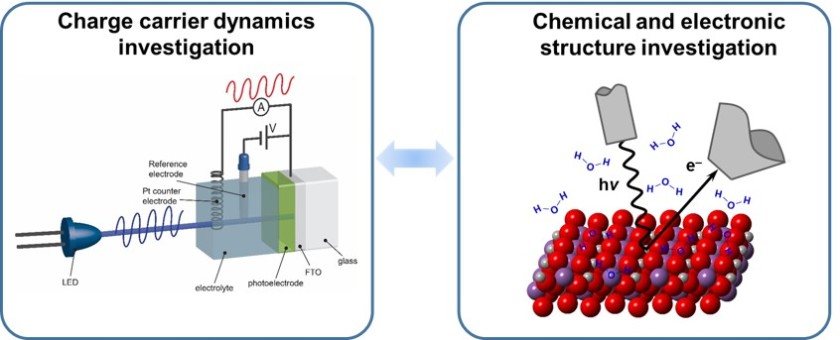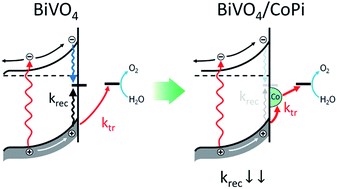Institute Solar Fuels
Interfaces
Introduction
While light absorption is central to any solar fuel device, processes at the interfaces are no less critical. In an operating device, charge is transferred across both solid-solid and solid-electrolyte interfaces. If not controlled properly, extensive charge carrier recombination can occur at these interfaces leading to a decrease in device performance. In the Institute for Solar Fuels understanding the role of interfaces in device performance is a major research theme. We focus on correlating molecular level descriptions (chemical composition and electronic structure) with the charge transfer properties of the interface.
Our approach
At the Institute for Solar Fuels, we focus on understanding processes that occur at both the solid-liquid (e.g., semiconductor-electrolyte, catalyst-electrolyte) as well as solid-solid (e.g., semiconductor-catalyst, semiconductor-protection layer) interfaces. We combine lab-based time- and frequency-resolved photoactivity measurements (e.g., IMPS, PEIS, SEC) and synchrotron-based spectroscopy measurements both in vacuum and in operando (e.g., AP-XPS, AP-HAXPES, and resonant photoemission techniques, to correlate the charge transfer and recombination kinetics with band alignment and chemical composition of the interface. Of particular interest is the detection of reaction intermediates and characterization of recombination centers. Through these correlations, we aim to provide a general design principle for minimizing losses at the interfaces in solar fuel devices.
Recent highlights
We observed that under illumination and open circuit potential bismuth phosphate forms at the BiVO4/potassium phosphate electrolyte interface, leading to an increase of the surface negative charge. The increase in negative charge leads to a re-distribution of the aqueous ions near the interface: both phosphate and potassium ions are repelled away from the BiVO4 The bismuth phosphate layer may act to passivate surface states observed in complementary photoelectrochemical measurements. Surprisingly, we find that such changes are reversible upon returning to dark conditions.
M. Favaro, F. F. Abdi, M. Lamers, E. J. Crumlin, Z. Liu, R. van de Krol, D. E. Starr, Light-induced Surface Reactions at the Bismuth Vanadate/Potassium Phosphate Interface, Journal of Physical Chemistry B
We showed that despite cobalt phosphate (CoPi) being an active dark electrocatalyst, its true role when deposited on BiVO4 photoelectrode is not a catalytic one. Instead, CoPi significantly suppresses surface recombination at the surface of BiVO4.
Zachäus, F. F. Abdi, L. M. Peter, R. van de Krol, Photocurrent of BiVO4 is Limited by Surface Recombination, not Surface Catalysis, Chemical Science, 8, 2017, 3712-3719



